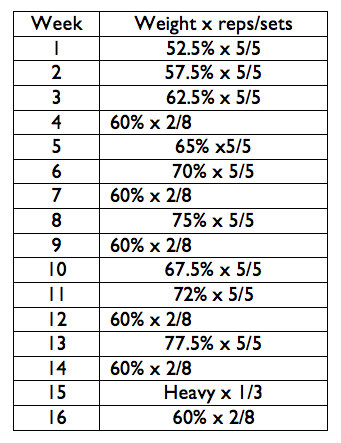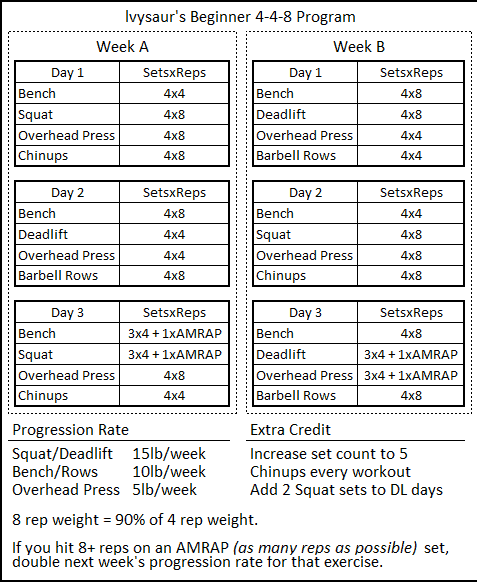Power Strenght Program 5x5 Calculator
Is a 5x5 routine good for adding strength? I also want to add some size but I mostly want to gain more strength. 5x5 strength routine for building strength? Muscle & Strength Forums.
Ever since the 1970s, weight trainers on this side of the Atlantic have been accustomed to measure training intensity as a percentage of one-repetition maximum (shortened to 1RM). For example, if your best overhead press is 200lb, then a 90% intensity lift would be 180lb, a lift at 80% would be with 160lb, and so on.
When you delve into the intricacies of exercise physiology, it becomes clear that intensity is not so easily calculated. But the percentage system is a good rule of thumb. It allows you to read through a workout routine and get a pretty good idea of how heavy or light a particular day in the gym is going to be.
Know Your Max Lifts
You all are probably aware of your 1RM in all of the lifts important in your training, regardless of whether that be weightlifting, powerlifting, bodybuilding, or general strength training. Some of you may also keep track of your maximums at other repetition ranges, such as your 3RM or 5RM. If you do, you have probably discovered that your maximum at any repetition range is fairly predictable once the 1RM is known.
Although trainees will vary slightly, it usually works out that a 2RM can be done at 98% of your 1RM, a 3RM can be done at 95%, and a 5RM can be done with 90% of your best. (Because few trainees concentrate on sets consisting of four reps, nobody seems to care much about what their 4RM would be.) Bodybuilders and other trainees interested in hypertrophy will probably be aware of their 8-12 rep intensities. As you might imagine, the higher the rep number, the more variable your probable percentages of 1RM will be.
Knowing your 1RM will help you design an effective training program.
Factor in Fatigue
This study of intensity becomes a little more interesting if we look at a standard 5x5 workout used in basic strength developments. Five sets of five reps are used at a constant intensity. This type of routine goes back at least as far as Mark Berry in the 1930s and has regularly been rediscovered. The late Bill Starr did so in the 1970s, while Mark Rippetoe and others hold it forth today.
Trainees are generally told to do 5x5 with a weight that they can just handle. They will invariably read somewhere that their best for 5 reps should be about 90% of their best single. So they will plan to do their 5x5 routine with 90%, straight across. Sounds logical, right?
Well, no. If you program your training this way, you may soon find that things don’t work out so neatly. If you indeed try to find your 90% of maximum poundage and then try to do it for five sets of five, you may run out of gas. This approach forgets to take into account the fatigue factor. To fully understand this factor, it is wise to look into what is happening at the muscle fiber level as you move through your sets.
Breaking Down Each Set
Let’s just take a look at the first set:
- Rep 1: Your 90% of maximum on your first rep feels just like that: 90% of your best.
- Rep 2: Probably a little bit more difficult. The 90% feels not like 90% anymore, but maybe more like 91%, give or take. The fatigue factor is starting to set in, although you may not notice it at this time.
- Rep 3: The fatigue factor remains. Rep number three may feel like 92%.
- Rep 4: Ditto.
- Rep 5: As far as your muscle fibers are concerned, this is 95%. The same energy that went into your fifth rep at 90% would be the energy you would need at a first rep with 95% of your best.
At the end of the set, you are visibly tired from the effort and breathing a little harder. That’s what you want. If you aren’t, you weren’t working with 90%. After that first set is done, it’s time to take a rest period of a few minutes. If you are a vigorous young athlete, you will return to normal in time for your next set, or at least it will feel like normal. But since you’ve already done one set, the fatigue factor still will be operative.
On your second set, you will take what you think is your 90%, but it is more likely about 91 or 92% of what your maximum is at that moment. If you were tested for your 1RM at that very minute, you would find that it is slightly lower than what it was originally. By the time you finish the second set, you’d probably be working with something that feels like 96% of your 1RM.
It will continue this way throughout your third, fourth, and fifth sets. Your percentages will go down with each rep and with each set as you proceed through your workout. Ideally, your 25th rep will feel like 100% as far as your muscle fibers are concerned. It would appear that your workout is a success. But is it?
5x5 is one of the most effective progressive training models, if you choose your weights wisely.

Perceived vs. Actual Intensity
What this all means is that your average real intensity for all sets might be somewhere at the 95% mark, not 90% as you would’ve assumed from the nominal weight on the bar. You will generally find that you start to power out on the fourth or fifth sets and may not be able to finish them.
While you might be frustrated by this, you should realize it is normal, due to the fatigue factor. You may have to be content with four or even three reps in your final two sets. On your next workout day, hopefully you can do better and complete them all, or least more of them. The obsessive-compulsive trainees among you might want to do the extra reps in another shorter set or a back-off set.
Calculating Your Ideal Training Weight
At this point, you may be wondering about the best “percentages of your percentages” when doing your 5x5 workouts. The most common figure I see is that a 5x5 workout is best done with about 81% of your 1RM. That works out to about 90% of your desired 90% intensity. I have experimented with this myself, and it appears to be accurate. Your first reps will feel easier than they should be, but your last ones will be done at what seems like 100%.
:max_bytes(150000):strip_icc()/GettyImages-543195255-5a9246533de42300375205af.jpg)
While this principle works at all rep and set levels, it is obviously going to be less noticeable when doing the lower rep and set regimes. Fatigue is less significant there. The opposite holds with higher rep regimes, as in bodybuilding. The first set will be easy, the last will be a killer.
The bottom line is that you cannot use the same percentage for five sets as you would for a single set, no matter what percentage of your 1RM you are working with. The fatigue factor will alter your maximum capabilities as a training session advances.
Training routines have to be planned with this in mind. So either start your sets with weights lower than your true 5RM, or accept that the full five sets will not be completed if you use your true 5RM.
More Sets and Reps Training Advice:
Photos courtesy of Jorge Huerta Photography.

StrongLifts? Hear me out. It might be better than you think.
Starting stats:
Height: 195cm / 6'5'
Age: 32 / don't know US conversion?
Weight: 117.5kg / 258lbs -> 121kg / 267lbs
Squat: 205kg / 452lbs max at IPF competition -> same weight for a triple
Bench: 125kg / 276lbs max -> same weight for a triple
Power Strenght Program 5x5 Calculator For Sale
Deadlift: 260kg / 563lbs max -> no change
Background:
I've been powerlifting for around two, maybe two and a half years. I lifted for fitness before that, but never took it particularly seriously. I did my first competition after retiring from basketball in 2016, and another in November last year where I hit the totals listed above. To reach those numbers, I had tried Sheiko (29/37/40) without a great deal of success, Greg Nuckols' StrengthTheory programs with some success, and my own programming based on what worked for me and what didn't.
StrongLifts:
Why StrongLifts? I came across the Advanced program one day and the plan looked solid for where I thought my strength levels were at. I hadn't moved much significantly for a few months, so I needed a bit of a change. Keep in mind here I am really focussing on my squat and bench, and not so much my deadlift. I pretty much stayed on maintenance for the deadlift for the duration of the program.
The program called for performing squat, bench and barbell row on Monday; squat, overhead press and deadlift on Wednesday; and squat, bench and barbell row again on Friday. Monday's squat session was five straight sets of five reps, while Friday's ramped up to a top set of five. The opposite happened for bench; Monday ramped, Friday straight sets. After four weeks, there's a de-load week and then the program moves on to four weeks of three sets of three, again with the straight/ramped - ramped/straight sets.
An example of this:
FIVE WAVE
THREE WAVE
(note these workouts aren't sequential, just two mid-wave examples of set-rep structure)
Awake the rise of mannimarco. What I changed:
I'm not a huge fan of multiple compound lifts on the same day, but sometimes I'm strapped for time and just have to do it. I also prefer going to the gym Sunday, Monday, Wednesday, Thursday so I did a squat or bench session for each of the straight/ramped types once per gym day. Assistance basically consisted of weighted carries and ab work for squat, and powerbuilding-type exercises for bench. If you want any more information on these, just ask - I've got a log.
What I did wrong:
On week four I was supposed to ramp up to a top set of 5x172.5kg on the squat, which would have been 7.5kg shy of my five rep PR. I misread my program and did 5x5x177.5kg instead. Whoops.
Stronglifts 5x5 Calculator
What I did right:
See entry above. That was a massive win for me.
Summary:
I really like the straight/ramped sets, where the heavy top set from one workout prepares you for the 5x5 in the next. The weights do go up very quickly (my top sets of five squats this round go 155->175->192.5->202.5) so it's obviously not going to be the best choice for advanced lifters (despite the name). However, I would definitely recommend it from anyone hovering around a 1.5xBW squat, 1xBW bench and a 2xBW deadlift.
Depending on which 1RM calculator I used, I gained anywhere from a conservative 16.8kg/37lbs to an optimistic 30.2kg/66.4lbs in nine weeks, so don't let the name StrongLifts put you off giving this a crack. More information about the program, and the spreadsheet itself, can be found at http://stronglifts.com/stronglifts-advanced/
5x5 Workout App
Comments are closed.